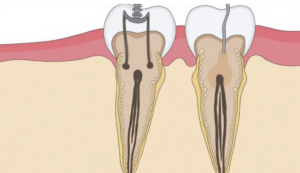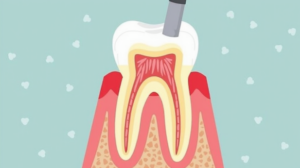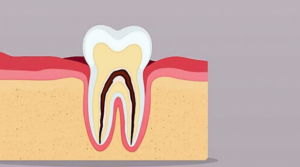Root canal therapy is a dental procedure that saves teeth from extraction by removing infected or damaged pulp from inside the tooth. This treatment relieves pain and preserves your natural smile. Let’s explore the details of root canal therapy and why it’s an important dental procedure.
Key Takeaways:
- Root canal therapy saves teeth by removing infected pulp
- The procedure is typically painless and completed in 1-2 visits
- Recovery is quick, with most patients returning to normal activities the next day
- Root canals have a high success rate of over 95%
- Costs vary but are often more affordable than tooth extraction and replacement
- Regular dental check-ups can help prevent the need for root canal therapy
Understanding Root Canal Therapy

Root canal therapy is a dental procedure that treats the inside of the tooth. When the soft tissue inside the tooth, called the pulp, becomes infected or inflamed, a root canal is needed to save the tooth. This treatment removes the damaged pulp, cleans the inside of the tooth, and seals it to prevent future infections.
When is Root Canal Therapy Needed?

There are several reasons why you might need a root canal:
- Deep decay that has reached the pulp of the tooth
- Repeated dental procedures on the same tooth
- A crack or chip in the tooth
- Injury to the tooth, even if there’s no visible damage
Signs You May Need a Root Canal
Recognizing the signs that you might need a root canal is important. Some common symptoms include:
- Severe tooth pain when chewing or applying pressure
- Prolonged sensitivity to hot or cold temperatures
- Discoloration of the tooth
- Swelling and tenderness in nearby gums
- A persistent or recurring pimple on the gums
If you experience any of these symptoms, it’s important to see a dentist right away. Early treatment can prevent the infection from spreading and save your tooth.
The Root Canal Procedure: Step by Step
Understanding what happens during a root canal can help ease any anxiety you might have about the procedure. Here’s a breakdown of what you can expect:
Initial Examination
Your dentist will first take X-rays to see the shape of the root canals and determine if there are any signs of infection in the surrounding bone. They’ll then numb the area around the tooth with a local anesthetic.
Preparing the Tooth
Once you’re numb, your dentist will place a rubber dam around the tooth to keep it dry and free of saliva during the procedure. They’ll then make an opening in the crown of the tooth to access the pulp chamber.
Cleaning the Tooth
Using special tools, your dentist will remove the damaged pulp from the pulp chamber and root canals. They’ll then shape the space for filling.
Filling the Tooth
After cleaning and shaping, the root canals are filled with a rubber-like material called gutta-percha. This seals the canals to prevent future infections.
Final Steps
Finally, a temporary filling is placed to close the opening. You’ll need to return to have a permanent crown or other restoration placed on the tooth to protect it and restore full function.
Recovery After Root Canal Therapy
Recovery from a root canal is typically quick and straightforward. Most people can return to their normal activities the day after the procedure. Here’s what you can expect:
Immediate Post-Procedure Care
- Your mouth may feel numb for a few hours after the procedure
- Avoid eating until the numbness wears off to prevent biting your cheek or tongue
- Take over-the-counter pain relievers if needed for any discomfort
The First Few Days
- Some mild discomfort or sensitivity is normal for a few days
- Avoid chewing on the treated tooth until it’s fully restored
- Continue your normal oral hygiene routine, brushing and flossing carefully around the treated area
Long-Term Care
- Schedule a follow-up appointment to have a permanent crown or filling placed
- Continue regular dental check-ups to monitor the treated tooth and your overall oral health
Myths and Facts About Root Canal Therapy

There are many misconceptions about root canal therapy. Let’s clear up some common myths:
| Myth | Fact |
|---|---|
| Root canals are painful | Modern techniques and anesthesia make root canals virtually painless |
| It’s better to pull the tooth | Saving your natural tooth is always the best option when possible |
| Root canals cause illness | There’s no scientific evidence linking root canals to other health problems |
| Root canals take many appointments | Most root canals can be completed in one or two visits |
The Cost of Root Canal Therapy
The cost of a root canal can vary depending on several factors:
| Factor | Impact on Cost |
|---|---|
| Location of the tooth | Molars are typically more expensive due to the complexity |
| Severity of infection | More severe cases may require additional treatment |
| Dentist’s experience | Specialists may charge more than general dentists |
| Geographic location | Costs can vary by region |
While root canal therapy may seem expensive, it’s often more cost-effective than extracting the tooth and replacing it with an implant or bridge.
Preventing the Need for Root Canal Therapy
While root canals are an effective treatment, it’s always better to prevent the need for one in the first place. Here are some tips to keep your teeth healthy:
- Brush twice a day with fluoride toothpaste
- Floss daily
- Avoid sugary foods and drinks
- Don’t use your teeth as tools (e.g., to open packages)
- Wear a mouthguard during sports
- Visit your dentist regularly for check-ups and cleanings
When Root Canal Therapy Isn’t Enough
In some cases, a tooth may be too damaged to save with a root canal. Alternatives include:
- Tooth extraction followed by a dental implant
- Tooth extraction followed by a bridge
- Partial denture to replace the missing tooth
Your dentist will discuss these options with you if a root canal isn’t possible.
The Future of Root Canal Therapy
Dental technology is always advancing, and root canal therapy is no exception. Some exciting developments include:
- 3D imaging for more precise treatment planning
- Laser-assisted root canals for even greater precision
- Regenerative endodontics to regrow damaged pulp tissue
These advancements promise to make root canal therapy even more effective and comfortable in the future.
Choosing a Dentist for Your Root Canal
Selecting the right dentist for your root canal is crucial. Consider these factors:
- Experience with root canal procedures
- Use of modern technology and techniques
- Patient reviews and testimonials
- Comfort level with the dentist and staff
Don’t hesitate to ask questions or seek a second opinion if you’re unsure.
Conclusion:
Root canal therapy is a valuable dental procedure that can save your natural tooth and relieve pain. With modern techniques, it’s a comfortable and effective treatment option. By understanding the process and taking good care of your teeth, you can maintain a healthy, pain-free smile for years to come.
Root canal therapy, often misunderstood as a painful procedure, is a vital dental treatment designed to save infected or damaged teeth. This procedure involves removing the inflamed or infected pulp from inside the tooth, cleaning and disinfecting the area, and then sealing it to prevent further infection.
Millions of root canals are performed each year, helping patients alleviate pain and preserve their natural teeth. If you’re experiencing tooth pain or sensitivity, don’t wait for the discomfort to worsen. Contact your dentist today to discuss whether root canal therapy is the right solution for you. Your smile deserves the best care!
